In this blog post, I will explore how many factors – both technological and ideological – have affected changes in the development of the illustration of children’s books. Within contemporary children’s literature criticism, it is argued that ‘children’s books’ can be for readers of any age (Beckett 2008). This age crossover is obvious in the case of popular fiction titles across centuries, such as Robinson Crusoe, which has been adapted to children’s fiction, a pop-up version of which can be seen below. Whereas literature marketed primarily to adults has traditionally been adapted to the child audience, in more recent decades, children’s books have been making their way into the adult market[1] . But, how did a literature for children emerge and how do past messages contained in children’s books inform manifestations of books made specifically for children today?
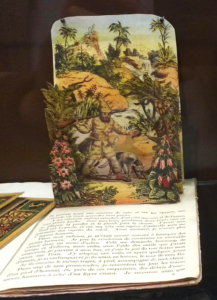
Through my position as Artist-in-Residence at the children’s literature archive in the Museum of Childhood, I have been lucky enough to be able to explore this question for my personal research. As a starting point for this topic, I examined chapbooks held in the archive at the Museum of Childhood, which has bindings from the seventeenth century. Chapbooks were the first articles of printed literature that were affordable for families in Britain and had influence in their daily lives. The content was varied and covered many subjects and stories including nursery rhymes, morals and fairytales, but also, crude jokes and stories of an adult nature (more information here). These chapbooks were not usually made for a specific age of audience, it was only in novels of the twentieth century that illustration began to be omitted from books for adults (Michals 2014). Therefore, up until fairly recently, illustration was a part of most literary prints for all ages.
Illustration both for chapbooks and bound books had until the early nineteenth century been printed using woodblocks, which, though often skilful, were sometimes crudely printed. In the case of chapbooks, the woodblocks could often be worn and mismatched with colour sometimes painted by hand. Three examples of woodblock-printed chapbooks from the archive are shown below:

The presses that were used to print such chapbooks were forms of the Gutenberg press, which uses a flat ‘platen’ and screw mechanism to exert pressure evenly on the paper below. The Gutenberg and similar designs of press that would have printed chapbooks were originally made from wood; later, they were made from cast iron, which made more precise prints. An example of a press used in Edinburgh is the Columbian Press; one of these presses is on display in the National Museum of Scotland in Edinburgh, pictured below:
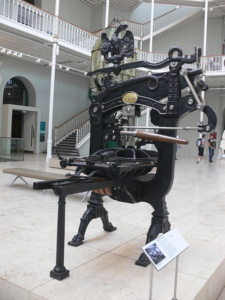
As printing production technologies advanced, the illustration of children’s books became more detailed and explorative. By the late eighteenth century, illustrators’ drawings could be reproduced in books using the more refined process of metal-plate etching, a method capable of achieving finer detail than the previous woodcut (Whalley & Chester 1988). Etching, or ‘intaglio’[2] printing, could provide a reproduction of a much finer pen and ink drawing made by the illustrator, which would have been transferred to a copper plate by the engraver, and then printed using a ‘mangle’ type press. Colour could also be added using woodblocks to give hue and tone to the intricate linework achieved through the intaglio process (Salisbury & Styles 2012).
The results of these new reproduction processes enabled representations of stories depicted in books to become more exact and specific. Illustrators were able incorporate popular stylistic trends from the fine arts, such as in the art of Victorian illustrator and book designer Laurence Housman, who used of art nouveau in his drawings for Goblin Market (Rossetti 1862) seen below:
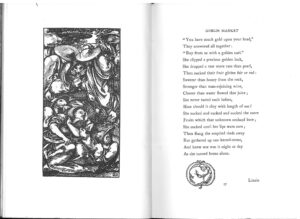
As the nineteenth century progressed, a process of printing using oil-based ink and water-resist was invented called ‘lithography’. Lithography allowed for both linework and colour to be printed more quickly and efficiently. Printing as an industry boomed with steam-powered presses, and, alongside these technological advances, how society thought of children in the nineteenth century was also rapidly changing.
Generally speaking, before the Enlightenment period, children worked alongside their elders from the age of eight and assumed adult responsibilities and dress (Cunningham 2012). This changed as a consequence of industrialisation and urbanisation; campaigners began to seek to protect children from dirty and dangerous labour. Children began to be thought of as part of nature and, through the process of ‘becoming social’, joined the civilised, adult world (Prout 2005, p. 67). This idea was expounded by Rousseau (1762), who likened childhood to primitivity and argued that children are inherently ‘good’ and adult society corrupted (Whalley & Chester 1988).
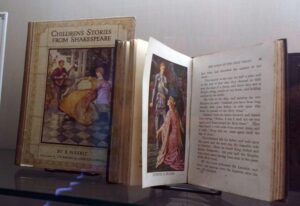
Interestingly, Chester and Whalley point out that there is a visual change in the depiction of children in literature from the first publications during the nineteenth century:
“In the earliest books, children were shown as young adults … At the beginning of the 19th century they were depicted more as children … by about the 1840s, or even earlier, we sometimes get the feeling that the artist was making a conscious comment on the child: ‘See how quaint – cute – amusing – pretty’ he is saying to us, the onlookers’” (1988, p. 53).
As described by Chester and Whalley, examples shown in the pictures below show how illustration coded attitudes towards childhood by othering the audience they were made for. This change in adults’ view of young people is linked to children’s exclusion from the workplace and, the stress of living in close, dirty cities away from nature, as was described earlier.
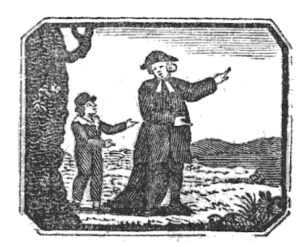
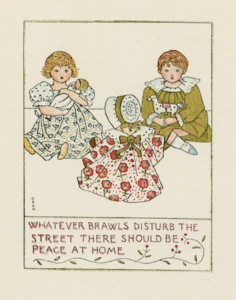
In the first woodcut image by an unknown wood engraver, the child is dressed similar to the adult and their posture is similar; it shows the child learning from the adult, but does not portray the youth as naive. However, in the latter illustration by Mrs. Arthur Gaskin (c.1899) the children look almost like dolls; their dress is extravagantly floral and their faces are flushed with innocent expressions that looked oddly blank. Though the woodblock engraver was restricted in terms how detail and colour, it is a striking difference from the vision of childhood shown in Gaskin’s illustrations.
The romantic concept of childhood remains evident in the censoring of children’s books today, though there are signs of a changing notions of what childhood is in the twenty-first century. Notably, I Want my Hat Back by Jon Klassen alludes to the insincerity that children are aware of and perform in the same way as adults. This picturebook ends with the audience sharing in a sinister joke that the bear ate the rabbit and is guilty (Klassen 2011).
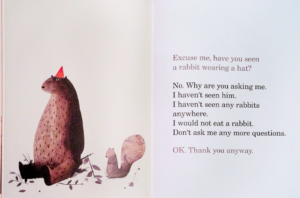
In today’s busy, scheduled lifestyles in modern, urban society, it is interesting that books such as Klassen’s are extremely popular. They appear to acknowledge that children are not faultless and are able to make moral decisions. This attitude to childhood is reflected by sociologist Alan Prout: “… the appeal of the idea of children as active and socially participative can be traced to the obvious advantage that such children would have in the everyday management of household timetables” (Prout 2005, p. 24). Additionally, this book and others by Klassen are bought for adult-reading too:
“The negotiations between what grown-ups and children want, and between what adults are familiar with and children are still apprehending, provide the tension that makes children’s books possible” (Sutton 2012).
These ideas challenge the long-established Rousseauian, Western view of childhood as innocent, as inferior and in need of civilising. The concept of contemporary childhood, then, has a direct effect on the way illustrators construct images for picturebooks.
To summarise, as is evidenced in Edinburgh’s Museum of Childhood archives, literature made for children is continuously adapted to new demands and challenges within society. Contemporary books for children, such as Klassen’s, act as sites of tension between preceding generations and the next, exploring new ways of viewing and defining what it means to be a child. A selection of books from the archive are currently on display in the exhibition Growing Up With Books, open until December 9th!
This post was written by SELCIE Artist-in-Residence Katie Forrester
Works Cited
Beckett, Sandra (2008) Crossover Fiction: Global and Historical Perspectives. New York, USA & Oxon, England: Routledge.
Cunningham, H. (2012) The Invention of Childhood. London: Random House.
Maclean, Robert (2012) “Book illustration: engraving and etching.” https://universityofglasgowlibrary.wordpress.com/2012/08/28/book-illustration-engraving-and-etching/
Michals, Teresa (2014) Books for Children, Books for Adults: Age and the Novel from Defoe to James. Cambridge: Cambridge University Press.
Prout, Alan (2005) The future of childhood: towards the interdisciplinary study of children. London, New York: Routledge.
Salisbury, M. & Styles, M. (2012) Children’s Picturebooks: The Art of Visual Storytelling. Laurence King Publishing.
Sutton, R. (2012) “Little Tug” and “This Is Not My Hat.” The New York Times. Available at: https://www.nytimes.com/2012/11/11/books/review/little-tug-and-this-is-not-my-hat.html.
Whalley & Chester (1988) A history of children’s book illustration. London: J. Murray with the Victoria & Albert Museum.
For more information on book illustration:
https://lithub.com/a-brief-history-of-book-illustration/
http://www.designishistory.com/1450/printing-techniques/
https://www.nls.uk/collections/rare-books/collections/chapbooks
[1] Most notably fantasy fiction authors such as JRR Tolkein, Phillp Pullman and JK Rowling.
[2] ‘Intaglio encompasses a variety of different techniques including engraving, etching, stipple, aquatint and mezzotint. While each of these techniques implies a different method of making impressions in the metal (usually copper) plate, they all share the same basic principle: an image is transferred to paper, under pressure, from the incised ink-bearing grooves of a metal plate’ (MacLean 2012).


